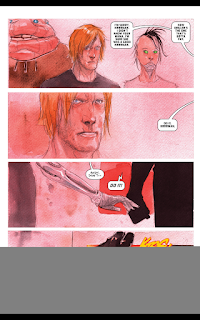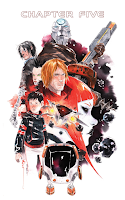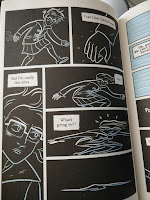THE PLOT
Elijah is a highly-reputed veteran officer of the Philosophical Police in the galactic Union. His job is solving conflicts by focusing on discovering the core problem to bring conflict to a halt. Life in the Union is egalitarian. People don't have to die unless they want, when and how they want. Their bodies can be cloned and merged at will, each clone or echo will share common memories and create new ones. When a merging occurs, only the primary body survives and all the memories are merged into one, but the oldest ones are destroyed in the process. The Union has appointed Elijah as mediator in the conflict between the Ganedans and the Alephs, two civilisations that are on the brink of war for something that happened centuries ago. At the same time, Elijah's personal life is leading him to question whether he wants to live beyond his current body's life span and what matters to him most in life.
.
THE STORY AND MAIN THEMES
I love abstract books, philosophical quests, science fiction and stories
that explore new territories in the world of graphic novels. Last Days of an Immortal does so perfectly. The novel really gets under your skin, in a very subtle but pervasive way, perhaps not the first time you read it, perhaps the second; that was my case. The world depicted and the story are intriguing, thought-provoking
and pose readers awesome existential questions. The story, most importantly, has a heart, a gaseous-like sentimentality that is not dramatic or overly out there. I found the concept of echoing really ingenious, like an organic positive split-personality disorder. I loved some of the humour in the novel, like when Elijah sleeps with one of his echoes. He and his self.
Vehlman's Last Days of an Immortal is an almost-happy Utopia. A world that is multi-racial and multi-ethnic. An egalitarian society where gender differences are non-existent, where men and women pair with people of both sexes, because the body doesn't matter. An age when women are strong, intelligent and feminine in different ways and formats. A time where age and death do not matter per se. A world where the way you look or what you wear is not relevant; you can dress or go naked, as you wish. A space where people from different cultures live together even though they not always understand each other. A society in which conflict is managed in a way that people don't hurt each other on purpose. In short, a society where judgement is minimal and conflict is analysed and tackled through philosophical reasoning.
So, what are the main themes in this book? Vehlman's himself poses the first question on the book's back cover:
"When you live forever, what will you live for?"
The story partially replies to this question. Of course, the query is for you to ponder, i.e. to ponder about your own mortality, eternity, immortality and what eternal life is to you.
To me, the most interesting questions are always those embedded in the story, those never said but whispered, those hidden in the story itself for the reader to discover and reveal. Some of the ones that came to me are the following:
~*~ What does Philosophy serve for in our world? Is Philosophy an empty babble?
Philosophy is presented as something practical, usable, a successful
tool to 'get' the world and the other, a door to approaching alterity. Philosophers
aren't verbose people, are very sensitive tuned people who solve real
problems and conflicts. That is utterly cool to me. I love the way the story shows that Philosophy is not empty
rhetoric but a way of approaching reality and other sentient beings.There is an episode
in the novel that shows this perfectly. Elijah is confronted by a guy in
the spaceport by an annoying guy that tells him what philosophers do
this and that, mocks the way they talk, but Elijah replies to him:
"You're confusing rhetoric and philosophy" (pp. 101).
~*~ What is the key to interpersonal communication? Is it possible to really understand the other, the "alien"?
To be perfectly frank, humanoid and non-humanoid races are equally hard to understand. -- What do affect us, however, are the expectations we bring to the encounter. -- Part of us imagines contact will go more smoothly with aliens who look like us. In the end, our disappointed expectations are to blame for making it seem more difficult. (p. 6)
~*~ Can we trust our eyes without questioning ourselves about what we have just seen?
The story stays, be aware that what you see is not a perceptive projection. You cannot fully trust your senses or your reasoning without using meta-consciousness or double questioning yourself.
"You just don't ask yourself the same questions when you see things
and when you hear about them, is all. You take in things differently."
(p. 46) "We think the same things, to varying degrees. We suffer from the same worry -- And this has formed a knot in our minds. It keeps us from making any progress on the case" (p. 130)
~*~ Can we judge other cultures without knowing their basic codes and how they approach reality?
I thought the way Elija's planet works is just awesome to understand how people should approach refugees and immigrants when they are from other cultures and have different languages and social and interpersonal codes. Also, which level of understanding we hope from there, and which problems may arise out of just simply cultural misunderstanding. The whole episode with G'Ohi shows just that.
~*~ Is our world a Ganedan-like theatre with assigned roles we play since we are born?
"We knew their way of life was filed by a kind of ritual theatre, but I didn't realise the degree of subtlety available. -- Everything's a game for them. Everything is theatre, down to the last detail. -- At various key moments in their life cycles , Ganedans are randomly issued librettos describing the character they must play: job, social status, sexuality, language, etc. --Upon arriving, I myself received an offworlder's libretto indicating the limits of what I could say or do." (p. 47)
Doesn't sound familiar?
I strongly feel that the Ganedan society is very much a metaphor
of us Earthians as we are given cultural codes and social rituals since
we are born, and most people follow their role to the letter from birth
to death.
Life is a theatre for the Ganedans as it is for our society.
The story is a
ode to being understanding, to getting to know the others by getting to understand their cultures, their codes, their feelings and the motives behind their behaviour, and to solve any conflict by getting to understand if there is a conflict at all.
The story is a swan chant to the
body as receptacle of the soul not as an empty vessel that can be discarded; in that regard, the sex scenes aren't there for the sake of provoking; there is a direct connection between Elijah's feelings and his lovemaking in his old body instead of using a younger more attractive one.
The story is a love song to
the value of close friendship and love itself, which is what matters the most in the end. If we erase those memories we cherish, those that made us better people and gave us inner joy, are we really alive?
"You will only lose a few of your oldest memories. Isn't that the
fate of all immortals, in the end-to forget our past?" (p. 32)


My main criticism to the novel is what I experienced the first
time I read it -- it is a bit cold, it feels a bit cerebral and not emotional enough. So it is not everybody's cup of tea. However, there is heart in the novel, is just that Elijah's feelings and sensitivity aren't overly verbalised or dramatic, just hinted and developed throughout the story in a very subtle but distinct way.
THE ARTWORK
De Bonneval's artwork in the book is very elegant and minimalist, with very open spaces and landscapes, and minimal human figures, and drawn in in a very soft black and white, which becomes even softer when depicting the vanishing of an echo or when narrating episodes of the past. There are some beautifully creative and elaborate countryside landscapes, some of them naturalist and others creative. Some extra
fleur is added when depicting the Ganedians and the Alephs, human gatherings and the transportation hub.
The drawing style and imagery reminded me of some futuristic comics of the 1970s and 1980s mostly because the human figure seems to be surrounded by vast open spaces in which humans look diminute beings.
Regarding the design, some decorative arts and architecture of the 1960s-1970s came to mind: Le Corbusier and Frank Lloyd Wright's
organic architecture and the glassy interiors of the former,
Miró's mobile sculptures, the avant-garde opera costumes designed for
The Ballets Russes by several famous artists in the early 20th century, and several interior designs, especially chairs, very typical of the 1960s-1970s interior design.
Overall the drawing has inner coherence and, although it feels familiar, it doesn't remind me of anything that is not this novel. The drawing feels expansive at times, when Nature and the landscape dominates, but it is quite constricted and minimal others, usually in one-to-one conversations, merely because the text is as important as the artwork and there is a space constriction in some vignettes.
I love the lettering used in the book because it is not futuristic, it is a handwritten-alike, personal and human writing that contrasts with the very cold lab-ish interiors and ways of living in Elijah's world.


RENDERING FOR KINDLE
I was wondering why this ebook was so big in size, the novel being quite short and in BW. Well, that was until used the ebook and I realised that double tapping allows readers to individuate vertical vignettes to full-screen size, which is awesome. Besides, browsing page by page is great, as the sizing of each page allows readers to pinch in an out as much as you want without losing quality of image. My only complaint is that it is not possible to add a note.
WARNING
There is full explicit sex scenes in the book, so not a book for children.






























































